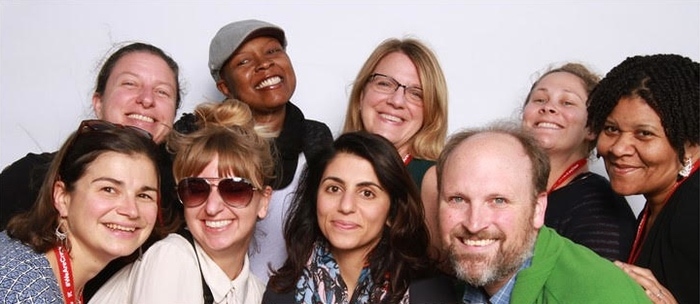Building Community
Got Staff? Get Cultured! The Key Ingredients to Nurturing Adult Learning Communities
Topics

When educators design and create new schools, and live next gen learning themselves, they take the lead in growing next gen learning across the nation. Other educators don’t simply follow and adopt; next gen learning depends on personal and community agency—the will to own the change, fueled by the desire to learn from and with others. Networks and policy play important roles in enabling grassroots approaches to change.
School leaders can face the challenges in education today by creating the conditions that motivate and support educators with specific leadership characteristics.
Public education is at an inflection point. The conditions in which teachers have been teaching and students have been learning have been challenging this past year. The social-emotional well-being of the members of our communities has been rocked by the pandemic and the seemingly nonstop barrage of news about violence directed at people of color. Educators are regularly contending with the impacts of pivoting between in-person and virtual learning.
On top of this, schools are facing unprecedented staffing shortages. Based on the National Education Association survey conducted at the start of 2022, approximately 55 percent of educators are more likely to resign, pursue other careers, or retire early.
These conditions are daunting. However, we can face these challenges with what we know about learning communities and leadership to create empowering and liberating spaces for not only our students but the adults that work in our schools as well.
In fact, beginning with the adults in our buildings is the greatest way to support our public education system to realize the outcomes we want for our students. In a time when many educators are reporting dissatisfaction with the profession, school leaders need to create communities where staff have a strong sense of purpose and belonging. Nurturing these types of communities will require specific leadership characteristics like vulnerability, bravery, transparency, and coalition building. It is only by cultivating the types of adult learning cultures where our teachers feel revived and excited about the work that we can hope to create the types of schools where students feel empowered by their learning.

The Conditions to Motivate Educators
While paying teachers more is always a good idea, job satisfaction matters more for teacher retention than salaries. School leaders can set the conditions to attract and retain educators by utilizing what we know motivates people.
Daniel Pink’s work on motivation provides a roadmap for creating environments where teachers want to be. To retain the educational workforce, his work suggests, schools should provide educators with a strong purpose, opportunities to master their craft, and space to be innovative. Of course, how these principles come alive will look different across schools. However, the principles still remain the same:
- Purpose: It is faulty to think that entering education alone is purpose enough. Leaders who clearly communicate and articulate an inspiring mission and vision for the school can help staff discover their individual “why” by seeing how their efforts contribute to the collective purpose of school teams. At Two Rivers the school's mission and vision are shared at the start of every school network event and professional development session. Additionally, during summer orientation, new hires to the school learn the story of the founding of Two Rivers and how the mission lives in our daily work. They also are given the opportunity to reflect and share what their contribution to the mission will be.
- Mastery: As Daniel Pink’s research highlights, everyone wants to get better at stuff. Thus, the school itself should be a learning community that supports both adult and student learning and growth. This means all members of the school are learners that are supported, receive feedback, and are committed to honing their craft. One of the professional learning structures at Two Rivers is our school-wide data analysis strategy (DAS) loop. Anchored by the school’s instructional focus, staff undergo learning, commit to implementing a pedagogical strategy, and bring back data to share with peers. Teachers are given autonomy on the data they share and the instructional steps they want to hone and master in collaboration with their professional peers.
- Autonomy: Everyone wants the opportunity and space for creativity and innovation. In a recent national teacher survey conducted by the EdWeek Research Center, lack of autonomy was one of the factors contributing to the negative state of the teaching profession. Teachers want more control over their time and instruction. Initially, one may think that this cannot be offered in the realm of education and in schools. However, there are ways to provide staff with opportunities for their work to be self-directed. The most critical element in bringing this principle to fruition is by naming what is non-negotiable. For example, at Two Rivers teachers are provided with schedules that consist of their scheduled “specials” blocks and know how many instructional minutes should be allotted for each content area. Given these non-negotiables, teachers are then given the autonomy to create their schedules.
To retain the educational workforce, schools should provide educators with a strong purpose, opportunities to master their craft, and space to be innovative.
The Characteristics of Leadership
However it isn’t enough to just cultivate the conditions where staff have a strong sense of shared purpose, opportunities to grow, and autonomy in their work. How you lead matters. When the three principles named above are coupled with the following leadership characteristics, school leaders can authentically show up and galvanize their community to work together to realize the shared vision.
- Vulnerability and Bravery: Strong leaders are able to name what they do not know, approach the work from a learner’s stance, and seek input from others. Vulnerability can show up by being self-reflective enough to name that as a leader you do not have all of the answers and by having trust in others to build a path together. For example, School Leader Lab executive director Erica Beal modeled this kind of bravery in her public reflection of her first months in the role. She shared the need to articulate vision while simultaneously having to give up control and trust her team with details of implementation. She encourages leaders to take on self-work because “by focusing on ourselves, we can be instruments to unlock the potential of others.” Modeling vulnerability opens the door for others to take this step.
- Transparency and Clarity: Leaders that are able to provide purpose in the workplace make the invisible visible. A common and often traditional way this is done is to communicate metrics for the goals, progress toward meeting them, and the obstacles and successes. Expanding Two Rivers from one campus to two campuses made some nervous and uneasy about what expansion would mean for our school. Founding executive director Jessica Wodatch carved out time to have listening sessions. She also named the angst tied to the change that was occurring within the organization. She provided the team with a common language and connected staff to the impact the expansion would have for students and families across the city. This example illustrates that not every decision made is going to be popular or accepted by all. However, when the team understands why specific decisions are made it provides transparency and clarity. This openness creates space for those that disagree to first voice their opinion, but then also to build an understanding of the rationale for final decisions. Understanding the purpose and how it relates to overarching goals creates space for even those who disagree to stay committed to the work with a clearer understanding of the “why.”
- Coalition Building: Battles are not won without allies. To build a coalition for decisions, school leaders must make those decisions with a diverse group of stakeholders at the table. This communicates the leader’s belief in their staff’s capacity to do the work and problem-solve. For example, in reopening the doors to our schools, former elementary school principal Caroline Mwendwa-Baker met with teachers to share an overall vision. She then gave teachers space to problem-solve and design a plan for bringing students back to in-person learning. By working directly with the teachers to understand their concerns as well as their hopes and dreams for returning, Caroline was able to craft a return plan that met the needs of her community while building the trust of the team that would implement the return.
The past two years have made it one of the most challenging periods for educators. Now more than ever, educators need school leaders to lean in on what has always been integral to strong schools—a positive adult work culture that is led with bravery, transparency, and team-building.
Photos courtesy of Two Rivers Public Charter School.




